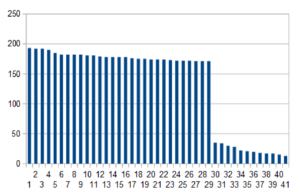I’ve blogged here and here and here about the sorry state of the backlog of PPH pet itions in the Office of Patent Petitions (OPP). OPP is just now getting around to deciding PPH petitions filed last August. Here are actual figures for forty-nine PPH petitions filed last August.
itions in the Office of Patent Petitions (OPP). OPP is just now getting around to deciding PPH petitions filed last August. Here are actual figures for forty-nine PPH petitions filed last August.
Of forty-nine PPH petitions filed last August, there is an inexplicable group of twelve petitions that got decided very quickly after filing. These are the very short bars toward the right in the graph above. I blogged about this group of quickly-decided petitions. To this day I have not heard any explanation from the USPTO as to why these petitions got decided promptly. And whatever odd circumstance within the USPTO led to that group of promptly decided PPH petitions, it has been “corrected” and all PPH petition decisions since then have been rendered in the usual fairly uniform slow way. For today’s blog article I will treat these twelve cases as outlying data points that should be ignored in evaluating the OPP’s current productivity.
Twenty-nine of those 49 PPH petitions got decided in the usual unacceptably slow way. These are the tall blue bars to the middle and left in the graph. The delay from filing to decision was in the range of 171 to 193 days, with the average delay being 179 days, or almost exactly six months.
179 days is, of course, unacceptable. The policy reasons why we have a PPH program (avoiding duplicative work by Examiners, making best use of work already carried out, reducing backlog of unexamined cases) are not well served when PPH petitions languish for many months rather than being decided promptly. In the early days of PPH, the PPH petition examiners had to evaluate and check lots of things. But in recent years the PPH system has been streamlined to the point where the petitioner is self-certifying nearly every condition that has to be satisfied for the petition to be granted. There is almost no work nowadays for the petition examiner to do. There’s just no excuse for USPTO taking so long to carry out this easy task.
so long to carry out this easy task.
The OPP dashboard claims (see table) that its pendency for PPH petitions has been 160 days. That’s just not true. From the above it is clear that the true number is not 160 days but at least 179 days.
Actually the true number is quite a bit more than 179 days. We have two PPH petitions filed in August that OPP has still not gotten around to deciding. One has been pending for 201 days and the other is still pending after 202 days.
Rather bizarrely, three of these 29 granted PPH petitions were granted after the first office action. According to the PPH source documents, one of the conditions for grant of a PPH petition is that the application not have received any Office Action. So these three PPH grants should not have happened. We won’t complain, I guess. The “special” status of each of these cases might end up being helpful if we find the need to pursue an ex parte appeal to the PTAB.
Another six of these PPH petitions have been dismissed or will never be granted, due to the fact that an Office Action has already been mailed. It might be suggested that this is a “no harm no foul” situation. After all, the petitioner presumably wanted an Office Action, and now has the Office Action. So where’s the problem, one might ask? And there are many reasons why this delay in OPP does harm the petitioner.
For one thing, the petitioner may have narrowed or cut back the claim set as part of bringing the application into condition for a PPH petition. Had the petitioner been able to know that the OPP would sit on the petition for so long, maybe the petitioner would have retained the original and broader claim set and could have gotten a search and examination of that original broader claim set. Instead the petitioner only received a search and examination of the possibly narrowed and cut-back claim set.
For another thing, the petitioner in this situation has lost the “special” status that would otherwise have forced the PTAB to treat an ex parte appeal as “special”.
It’s easy to imagine that an OPP petition examiner, taking up a petition for decision in a particular case, might look up the FOAP (first office action prediction) for that case and might see that an Office Action is just around the corner. In such an event, one can imagine that the petition examiner would be tempted to just “run out the clock” and wait for the Office Action to get mailed. This would permit the petition examiner to mail out a petition dismissal (and to take credit for the work of deciding a petition) without having to do any work at all. This avoids the pesky business of having to do the work (even though it is not very much work) that would normally be required to decide whether or not to grant the petition.
Some months ago I spoke with a couple of people at the USPTO who said that USPTO was taking steps to reduce this PPH petition backlog. I had hoped this might mean that the backlog was improving. Instead, these figures show that the OPP backlog is getting worse.

I recently received an determination on a PPH petition. I had already received an Office Action in the case.
Since the Examining Corps pays no attention to the ISA’s determination, what is the point of PPH?